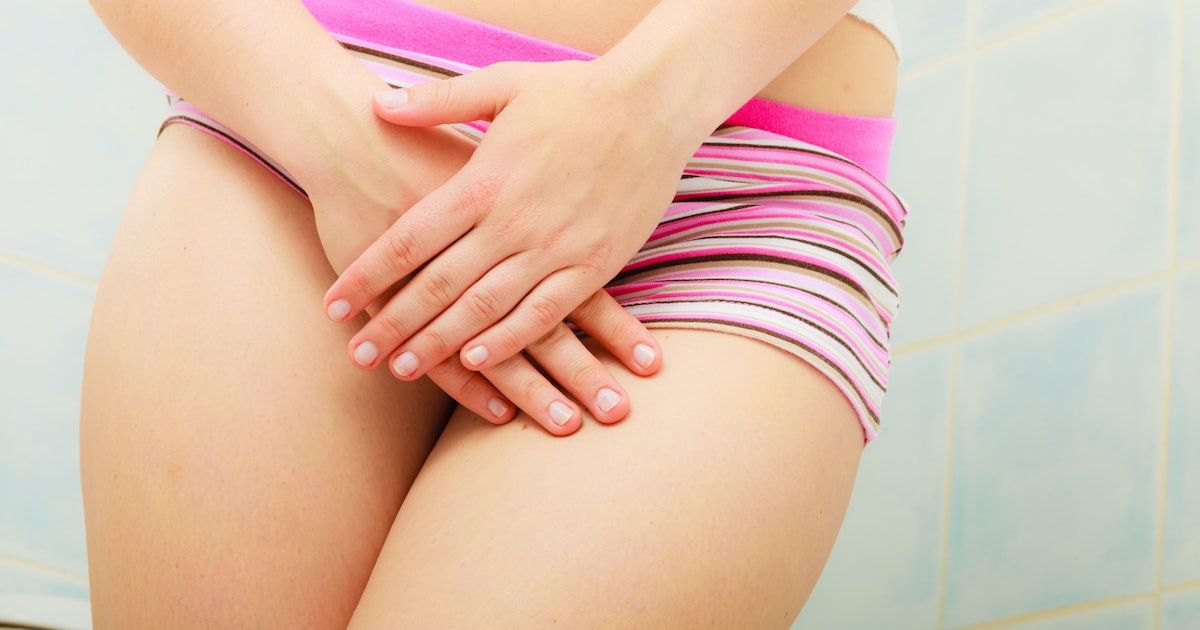

FAQs
Why Are My Panties Always Wet
Modified: August 24, 2023
Discover the answers to your general questions about why your panties are always wet. Find helpful solutions and tips to stay dry and comfortable.
(Many of the links in this article redirect to a specific reviewed product. Your purchase of these products through affiliate links helps to generate commission for Under-tec.com, at no extra cost. Learn more)
Table of Contents
- Introduction
- Understanding Vaginal Moisture
- Common Causes of Wet Panties
- Hormonal Changes and Vaginal Lubrication
- Excessive Sweating and Moisture
- Vaginal Discharge and Its Types
- Infections and Their Impact on Vaginal Wetness
- Hygiene Practices That May Contribute to Wetness
- Lifestyle Factors Affecting Moisture Levels
- When to Seek Medical Advice
- Conclusion
Introduction
Welcome to this comprehensive guide on a topic that many women may hesitate to discuss openly – why are my panties always wet? While it can be uncomfortable and embarrassing to experience excessive vaginal moisture, it is important to remember that it is a common occurrence and there are various reasons behind it.
Your body’s natural processes, hormonal changes, and external factors can all contribute to the moisture you may be experiencing. Understanding these causes can help you manage and address the issue effectively. This article aims to shed light on the different factors that can lead to wet panties and provide some guidance on managing them.
It’s essential to note that vaginal wetness is a completely normal and healthy phenomenon. The vagina has its own system of self-cleaning and maintaining a balanced pH level. The presence of moisture helps to keep the vaginal tissues lubricated and protected. However, if you are experiencing excessive wetness that is causing discomfort or distress, it may be worth investigating further.
In the following sections, we will explore common causes of wet panties, including hormonal changes, excessive sweating, vaginal discharge, infections, hygiene practices, and lifestyle factors. We will also discuss when it is advisable to seek medical advice. By the end of this article, you will have a better understanding of the possible reasons behind your wet panties and some strategies for managing the issue.
It is important to remember that every woman’s body is unique, and what is “normal” can vary from person to person. If you have any concerns about your vaginal health, it is always best to consult with a healthcare professional. With that being said, let’s dive into the various factors that can contribute to wet panties and explore possible solutions to help you feel more comfortable.
Understanding Vaginal Moisture
Vaginal moisture is a natural phenomenon that is essential for maintaining vaginal health and comfort. The vagina is lined with moist mucous membranes that produce fluids to keep the area lubricated and protected. This moisture helps to maintain a healthy pH balance and prevent dryness and irritation.
It’s important to distinguish between normal vaginal moisture and excessive wetness. Normal vaginal moisture is clear or slightly cloudy and may vary in consistency throughout the menstrual cycle. On the other hand, excessive wetness refers to an abnormal increase in vaginal moisture that may result in consistently wet panties.
Several factors can contribute to the production of vaginal moisture. Hormonal changes, such as those that occur during the menstrual cycle, pregnancy, or menopause, can increase vaginal lubrication. This is often most noticeable during ovulation when the body releases an egg. Increased blood flow to the genital area during sexual arousal can also lead to heightened moisture.
The amount of moisture can also vary depending on individual factors such as genetics, age, and overall health. Some women naturally produce more vaginal moisture than others. Additionally, external factors like humidity, exercise, and stress can influence vaginal moisture levels.
It is normal for vaginal moisture to have a mild odor that may change throughout the menstrual cycle. However, a strong or unpleasant odor, accompanied by itching, burning, or unusual discharge, may indicate an underlying issue that requires medical attention.
Understanding the normal range of vaginal moisture and becoming familiar with your body’s patterns can help you identify when there may be a deviation from the norm. Paying attention to your body and noting any changes, including excessive wetness, can guide you in determining whether further investigation or medical advice is necessary.
In the next section, we will explore common causes of excessive wetness and discuss how they may contribute to consistently wet panties. By gaining a better understanding of these causes, you will be better equipped to address and manage the issue.
Common Causes of Wet Panties
Experiencing consistently wet panties can be attributed to various factors. Let’s explore some of the most common causes of excessive vaginal moisture:
- Hormonal changes and vaginal lubrication: Hormonal fluctuations, such as those during the menstrual cycle, pregnancy, or menopause, can result in an increase in vaginal lubrication. Estrogen levels play a significant role in regulating the moisture levels in the vagina. During ovulation, estrogen levels rise, leading to heightened lubrication. Similarly, changes in estrogen levels during pregnancy can also contribute to increased vaginal moisture.
- Excessive sweating and moisture: Activities that cause excessive sweating, such as intense physical exercise or staying in a hot and humid environment, can lead to moisture buildup in the vaginal area. Sweat glands located around the vulva can contribute to wetness in the panties. The moisture from sweat may combine with vaginal fluids, resulting in a more noticeable wetness.
- Vaginal discharge and its types: Vaginal discharge is a normal bodily function and varies in consistency and color throughout the menstrual cycle. Increased vaginal discharge, particularly when it becomes watery, can contribute to the sensation of wet panties. Factors such as stress, sexual arousal, and ovulation can trigger increased production of vaginal discharge.
- Infections and their impact on vaginal wetness: Various infections, such as bacterial vaginosis, yeast infections, or sexually transmitted infections, can cause changes in vaginal moisture levels. These infections may lead to an overgrowth of certain microorganisms, resulting in increased vaginal discharge and moisture. It is important to note any changes in the odor, color, or consistency of the discharge, as these may indicate an underlying infection.
- Hygiene practices that may contribute to wetness: Certain hygiene practices, such as using scented soaps, douching, or wearing tight underwear, can disrupt the natural balance of vaginal flora and increase moisture levels. It is important to practice proper hygiene by using mild, unscented soaps and opting for breathable cotton underwear to maintain a healthy vaginal environment.
- Lifestyle factors affecting moisture levels: Factors like stress, diet, and medication can affect vaginal moisture levels. High levels of stress can disrupt hormone balance and contribute to increased vaginal moisture. Additionally, certain medications, like hormonal birth control or antihistamines, can affect vaginal lubrication. Diet can also play a role, as inadequate hydration can result in a decrease in overall moisture in the body, including the vagina.
By understanding these common causes, you can better identify the factors contributing to your wet panties and take appropriate steps to manage the issue. In the next sections, we will discuss how to address and alleviate excessive wetness based on the underlying cause.
Hormonal Changes and Vaginal Lubrication
Hormonal fluctuations in the body can have a significant impact on vaginal lubrication. Estrogen, in particular, plays a crucial role in regulating moisture levels in the vagina. Throughout the menstrual cycle, estrogen levels rise and fall, with the highest levels occurring during ovulation. This increase in estrogen stimulates the production of cervical mucus and results in heightened vaginal lubrication.
During sexual arousal, the body also experiences hormonal changes that contribute to vaginal moisture. As excitement and arousal intensify, blood flow to the genital area increases, leading to engorgement of blood vessels and secretion of cervical mucus. This natural lubrication facilitates comfortable penetration and reduces friction during sexual activity.
However, hormonal changes can also lead to imbalances that affect moisture levels. For example, low estrogen levels during menopause or breastfeeding can result in vaginal dryness. This can cause discomfort, pain during intercourse, and an increased risk of developing vaginal infections.
If you are experiencing consistently wet panties, it could be due to hormonal changes that are causing increased vaginal lubrication. This is especially common during ovulation, when estrogen levels are at their peak. Understanding your menstrual cycle and tracking changes in vaginal moisture throughout the month can help you identify patterns and determine if hormonal fluctuations are contributing to the issue.
If you suspect that hormonal imbalances are causing excessive moisture, it is recommended to consult with a healthcare professional. They can assess your hormone levels and provide appropriate treatment options. Hormone replacement therapy (HRT) or natural remedies such as vaginal moisturizers or lubricants may be recommended to address any imbalances and alleviate wetness.
In addition to medical interventions, there are self-care practices that can help manage vaginal moisture caused by hormonal changes. These include wearing breathable cotton underwear, avoiding excessive washing or harsh soaps that can strip away natural moisture, and staying hydrated to support overall vaginal health.
It is important to note that hormonal changes are a natural part of a woman’s reproductive cycle, and some degree of vaginal moisture is to be expected. However, if the wetness is causing discomfort or is accompanied by other symptoms such as a foul odor or itching, it is advisable to seek medical attention to rule out any potential underlying conditions.
Understanding the impact of hormonal changes on vaginal lubrication can provide insights into the possible causes of consistently wet panties. By addressing hormonal imbalances and adopting appropriate self-care practices, you can effectively manage the issue and maintain optimal vaginal health.
Excessive Sweating and Moisture
Excessive sweating, also known as hyperhidrosis, can contribute to wet panties and increased moisture in the vaginal area. Sweating is a natural function of the body that helps regulate body temperature, but when sweat production is excessive, it can lead to an uncomfortable, moist feeling.
There are several factors that can contribute to excessive sweating in the vaginal area. Physical activity, especially intense exercise or activities that cause a significant increase in body temperature, can trigger sweating throughout the body, including the vulva. The moisture from sweat can mix with vaginal fluids, resulting in a more noticeable wetness.
Hot and humid environments can also exacerbate sweating. High temperatures and humidity levels can lead to increased sweat production, further contributing to moisture in the vaginal area. Additionally, tight or non-breathable clothing can trap heat and moisture, creating an environment where sweating is more likely to occur.
When it comes to managing excessive sweating and moisture, there are several strategies you can try:
- Stay hydrated: Drinking an adequate amount of water throughout the day can help regulate body temperature and reduce excessive sweating.
- Wear breathable clothing: Opt for loose-fitting, cotton underwear and clothing that allows airflow. Avoid synthetic materials that can trap moisture and heat.
- Practice good hygiene: Regularly wash the genital area with mild, unscented soap and water. Be sure to dry thoroughly after washing to minimize moisture buildup.
- Use absorbent materials: Consider using panty liners or absorbent underwear specifically designed to manage moisture and keep you feeling dry throughout the day.
- Manage stress levels: Stress can trigger sweating, so implementing stress-reduction techniques, such as meditation or deep breathing exercises, can help minimize excessive sweating.
- Apply antiperspirant: Some antiperspirants are specifically formulated for use in the genital area. These products can help reduce sweat production and keep the area drier.
If excessive sweating and moisture persist despite these measures, it is advisable to consult with a healthcare professional. They can assess your specific situation and provide appropriate guidance and treatment options. For severe cases, medical interventions, such as prescription antiperspirants or Botox injections to reduce sweating, may be considered.
Remember, it is normal to sweat, and a certain level of moisture in the vaginal area is expected. However, if excessive sweating and moisture become a persistent issue that causes discomfort or affects your daily life, it’s important to seek medical advice to rule out any underlying conditions and find the most suitable management strategies.
Vaginal Discharge and Its Types
Vaginal discharge is a normal and healthy occurrence in women. It is the body’s way of cleansing and maintaining the health of the vagina. Vaginal discharge consists of a combination of cervical mucus, vaginal fluids, and cells shed from the vaginal walls.
Understanding the different types of vaginal discharge can help you differentiate between normal and abnormal variations. Here are some common types of vaginal discharge:
- Clear and Watery: This type of discharge is common during certain times of the menstrual cycle, particularly around ovulation. It is typically clear, thin, and slippery, resembling the consistency of raw egg whites. This discharge is associated with increased fertility and can indicate a prime time for conception.
- White and Thick: A thicker, white, or creamy discharge is also normal and can occur at various stages of the menstrual cycle. This type of discharge is more common during non-fertile periods and may somewhat resemble the texture of lotion.
- Milky and Mildly Odorous: It is common for vaginal discharge to have a mild odor, often described as slightly musky. This odor may change throughout the menstrual cycle but should not be foul or strong. Any change in odor that is accompanied by itching or irritation may indicate an infection and should be evaluated by a healthcare professional.
- Yellow or Greenish: Abnormal discharge that is yellow or greenish in color can be a sign of an infection, such as bacterial vaginosis or a sexually transmitted infection (STI). This type of discharge is often accompanied by a foul odor and may be accompanied by itching or burning sensations. If you notice these symptoms, it is essential to seek medical attention for diagnosis and treatment.
- Thick, Clumpy, or Cottage Cheese-like: A discharge that resembles cottage cheese or has a clumpy texture can indicate a yeast infection. Yeast infections are common and can occur due to an overgrowth of the fungus Candida. Along with the characteristic discharge, yeast infections often cause itching, redness, and irritation.
It is important to remember that every woman’s discharge may vary in color, consistency, and volume, but any sudden change in discharge that is accompanied by discomfort or an unpleasant odor should be evaluated by a healthcare professional. They can determine the underlying cause and provide appropriate treatment.
Maintaining good vaginal hygiene is crucial to preventing infections and maintaining a healthy balance of vaginal flora. Avoid using harsh soaps, douches, or scented products in the genital area, as these can disrupt the natural pH and lead to imbalances.
If you are uncertain about the normal range of vaginal discharge or have concerns about any changes you’re experiencing, it is always best to consult with a healthcare professional. They can address any questions or concerns you may have and provide guidance on maintaining optimal vaginal health.
Infections and Their Impact on Vaginal Wetness
Infections can significantly impact vaginal wetness and contribute to changes in vaginal discharge. When the vagina’s natural balance of microorganisms is disrupted, it can lead to an overgrowth of harmful bacteria or yeast, resulting in various infections and associated symptoms. These infections can cause an increase or alteration in vaginal wetness. Let’s explore some common infections and their impact on vaginal moisture:
- Bacterial Vaginosis: Bacterial vaginosis (BV) is a common vaginal infection characterized by an overgrowth of certain bacteria in the vagina. Symptoms may include a fishy odor, thin grayish discharge, and increased vaginal wetness. BV can disturb the natural pH balance in the vagina, resulting in changes in moisture levels.
- Yeast Infections: Yeast infections, caused by an overgrowth of the fungus Candida, can lead to vaginal dryness or an increase in vaginal discharge. This discharge is typically thick, white, and clumpy, resembling cottage cheese. It may also cause itching, redness, and irritation in the vaginal area. Yeast infections can affect vaginal moisture balance and cause changes in wetness levels.
- Sexually Transmitted Infections (STIs): Certain sexually transmitted infections, such as trichomoniasis or gonorrhea, can cause an increase in vaginal discharge and affect moisture levels. The discharge may be yellow or greenish and have a strong odor. STIs can disrupt the natural microbial balance in the vagina, leading to changes in discharge and moisture.
- Urinary Tract Infection (UTI): While UTIs primarily affect the urinary system, they can also have an impact on vaginal health. UTIs can cause increased inflammation and irritation in the vaginal area, leading to changes in vaginal discharge and wetness. This may include an increase in vaginal moisture or a change in its consistency.
If you experience changes in vaginal wetness, such as an increase or alteration in vaginal discharge accompanied by itching, odor, or discomfort, it is important to seek medical attention. A healthcare professional can accurately diagnose the specific infection and provide appropriate treatment.
Treatment for vaginal infections typically involves medication, such as antibiotics for bacterial infections or antifungal medications for yeast infections. It is important to complete the full course of treatment prescribed by your healthcare provider to effectively eliminate the infection and restore a healthy vaginal environment.
Prevention is key when it comes to infections and maintaining vaginal health. Practicing safe sex, maintaining good hygiene, avoiding douching or using harsh soaps in the genital area, and wearing breathable underwear can help prevent the occurrence of infections and minimize disruptions in vaginal wetness.
If you suspect you have an infection or have concerns about any changes in vaginal wetness, it is essential to consult with a healthcare professional. They can provide a proper diagnosis, recommend appropriate treatment, and offer guidance on how to maintain a healthy vaginal environment.
Hygiene Practices That May Contribute to Wetness
Maintaining proper hygiene is crucial for vaginal health, but certain practices can inadvertently contribute to increased wetness in the vaginal area. Let’s explore some hygiene practices that may contribute to wetness:
- Using Harsh Soaps: Using harsh, scented soaps or cleansers in the genital area can disrupt the natural balance of bacteria and pH levels in the vagina. This disturbance can lead to an overgrowth of harmful bacteria or yeast, resulting in increased vaginal wetness and changes in discharge consistency.
- Douching: Douching involves rinsing the vagina with a solution to cleanse or deodorize the area. However, douching can disrupt the natural balance of bacteria in the vagina and remove the healthy, protective vaginal secretions. This can lead to imbalances in moisture levels and increase the risk of infections.
- Wearing Non-Breathable Underwear: Wearing underwear made of synthetic fabrics, such as nylon or polyester, can trap moisture, heat, and bacteria in the vaginal area. This can create a humid environment that promotes excessive moisture and increases the risk of infections. Opting for breathable cotton underwear allows for better air circulation and can help minimize wetness.
- Wearing Wet or Damp Clothing: Sitting in wet or damp swimsuits, sweaty workout clothes, or wearing underwear that is not completely dry can create an environment where bacteria can thrive. Moisture trapped against the skin can lead to increased wetness and an increased risk of infections. It’s important to change out of wet or damp clothing as soon as possible and ensure proper drying before putting on fresh clothing.
- Not Changing Tampons or Menstrual Products Regularly: Leaving a tampon or menstrual product in for an extended period can increase moisture and create an environment where bacteria can grow. It’s important to change tampons regularly during menstruation and follow the recommended guidelines for using menstrual products to minimize moisture buildup and risk of infections.
- Improper Wiping Technique: Incorrect wiping technique after using the restroom, such as wiping from back to front, can introduce bacteria from the anal area into the vagina. This can lead to infections that can contribute to increased vaginal wetness. Always remember to wipe from front to back to avoid transferring bacteria.
If you suspect that your hygiene practices may be contributing to excessive wetness, making some adjustments can help restore the balance. Here are some tips for maintaining good vaginal hygiene:
- Use mild, unscented soaps specifically formulated for the genital area when cleansing.
- Avoid douching completely, as the vagina is self-cleaning and does not require additional cleansing.
- Choose underwear made of breathable fabrics, such as cotton, to allow for better air circulation.
- Change out of wet or damp clothing promptly to minimize moisture buildup.
- Ensure proper drying of the genital area after washing or using the restroom.
- Follow the recommended guidelines for changing tampons or menstrual products during menstruation.
- Practice proper wiping technique, wiping from front to back after using the restroom.
By adopting proper hygiene practices, you can help maintain a healthy balance of moisture in the vaginal area and reduce the risk of infections. If you have concerns about your hygiene practices or experience persistent wetness despite these adjustments, it is advisable to consult with a healthcare professional for further evaluation and guidance.
Lifestyle Factors Affecting Moisture Levels
Various lifestyle factors can influence the moisture levels in the vaginal area. Understanding and addressing these factors can help manage and regulate vaginal wetness. Let’s explore some common lifestyle factors that can affect moisture levels:
- Stress: High levels of stress can affect hormone levels in the body, including those that regulate vaginal moisture. Increased stress can lead to hormonal imbalances and result in changes in vaginal wetness. Managing stress through relaxation techniques, exercise, and self-care practices may help regulate moisture levels.
- Diet and Hydration: What we eat and drink can impact overall bodily moisture, including vaginal moisture. Inadequate hydration can lead to dehydration, reducing moisture levels throughout the body, including the vagina. Ensuring proper hydration by drinking enough water can help maintain optimal vaginal moisture. Additionally, a diet rich in fruits, vegetables, and omega-3 fatty acids can promote healthy vaginal function.
- Medications: Certain medications, such as hormonal contraceptives (e.g., birth control pills) or antihistamines, can affect hormone levels, potentially leading to changes in vaginal moisture. If you suspect that medications may be contributing to excessive wetness, it is advisable to consult with a healthcare professional for further evaluation and potential alternatives or adjustments to your treatment plan.
- Chemical Irritants: Exposure to certain chemical irritants, such as perfumed products, dyes, or harsh laundry detergents, can aggravate the delicate tissues in the vaginal area. This can disrupt the natural moisture balance and lead to irritation and abnormalities in wetness levels. Avoiding these irritants or using hypoallergenic products may help maintain optimal vaginal moisture levels.
- Smoking: Tobacco smoke contains chemicals that can negatively impact vaginal health. Smoking has been associated with reduced blood flow to the genital area, leading to decreased moisture production. Quitting smoking can help improve overall vaginal health and contribute to the maintenance of adequate moisture levels.
- Exercise and Physical Activity: Engaging in regular exercise and physical activity promotes overall well-being. However, intense workouts or activities that cause excessive sweating can contribute to increased moisture in the vaginal area. Ensuring proper hygiene practices, such as changing out of sweaty clothing promptly and maintaining good genital hygiene, can help manage increased wetness associated with physical activity.
Awareness of these lifestyle factors and their potential impact on vaginal moisture can help you make informed choices to regulate wetness levels. Incorporating stress management techniques, maintaining a balanced diet and hydration, avoiding chemical irritants, quitting smoking, and practicing good hygiene are all essential in supporting optimal vaginal health.
If you are experiencing persistent or excessive wetness that is accompanied by discomfort, an unpleasant odor, or other concerning symptoms, it is recommended to consult with a healthcare professional. They can evaluate your specific situation and provide appropriate guidance and support.
By considering and addressing lifestyle factors that affect moisture levels, you can cultivate a healthier vaginal environment and maintain optimal comfort and well-being.
When to Seek Medical Advice
While some variation in vaginal wetness is normal, there are certain circumstances when it is important to seek medical advice. Here are some instances where seeking medical attention is recommended:
- Unusual Odor: If you notice a strong, foul, or persistent odor accompanying the wetness, it may be a sign of an underlying infection or condition that requires medical evaluation and treatment.
- Unusual Color or Consistency: Any changes in the color, consistency, or texture of vaginal discharge should be evaluated by a healthcare professional. Greenish, yellow, or gray discharge can indicate an infection that requires medical attention.
- Itching or Irritation: Persistent itching, redness, or irritation in the vaginal area, along with excessive wetness, could be indicative of an infection or allergic reaction. These symptoms should be assessed by a healthcare provider for proper diagnosis and treatment.
- Pain during Intercourse or Urination: If excessive wetness is accompanied by pain during sexual intercourse or urination, it may be a sign of an underlying condition, such as a urinary tract infection or sexually transmitted infection. Seeking medical advice is essential for accurate diagnosis and appropriate treatment.
- Changes in Wetness Patterns: If you experience a sudden or significant change in wetness patterns, such as a sudden increase in wetness or persistent wetness that causes discomfort or impacts your daily life, it is advisable to consult with a healthcare professional for evaluation. They can assess the underlying cause and provide guidance on management strategies.
- Recurrent Infections: If you have a history of frequent or recurrent vaginal infections, it is recommended to seek medical advice. Chronic or recurring infections may require further investigation to determine the underlying cause and develop an appropriate treatment plan.
- General Concerns or Questions: If you have any concerns, questions, or uncertainties about your vaginal health or moisture levels, it is always a good idea to consult with a healthcare professional. They can provide guidance, offer reassurance, and address any specific concerns you may have.
Remember that everyone’s body is unique, and what is considered normal can vary from person to person. It’s important to trust your instincts and seek professional medical advice if anything feels unusual or concerning about your vaginal wetness.
A healthcare professional will be able to evaluate your individual circumstances, provide a proper diagnosis, and recommend appropriate treatment options if necessary. They can help determine whether the wetness is within normal limits or if further investigation is needed to address any underlying issues affecting your vaginal health.
Regular check-ups with a gynecologist can also provide opportunities to discuss any concerns about vaginal wetness and receive guidance on maintaining optimal vaginal health.
Don’t hesitate to reach out to a healthcare professional when in doubt. Your vaginal health is important, and seeking medical advice can help ensure that any issues are addressed promptly and effectively.
Conclusion
Understanding the factors that contribute to wet panties and vaginal moisture is essential for every woman’s overall health and well-being. Experiencing wetness in the vaginal area is a common occurrence, and in most cases, it is completely normal and healthy. However, if the wetness becomes excessive or is accompanied by discomfort, an unusual odor, or other concerning symptoms, it is important to seek medical advice for proper evaluation and treatment.
Hormonal changes, excessive sweating, vaginal discharge, infections, hygiene practices, and lifestyle factors can all influence vaginal wetness. Recognizing the impact of these factors can help you make informed decisions and adopt appropriate strategies to manage and regulate moisture levels.
Maintaining proper hygiene practices, such as using mild soaps, avoiding douching, wearing breathable cotton underwear, and practicing good genital hygiene, can help support a healthy vaginal environment and minimize excessive wetness. Additionally, managing stress levels, staying hydrated, following a balanced diet, and avoiding irritants can contribute to maintaining optimal vaginal health.
If you are experiencing persistent or unusual wetness that is accompanied by discomfort or other concerning symptoms, it is crucial to consult with a healthcare professional. They can evaluate your specific situation, provide an accurate diagnosis, and recommend appropriate treatment options.
Remember to trust your instincts and prioritize your vaginal health. By seeking medical advice when needed and adopting healthy lifestyle practices, you can maintain optimal vaginal moisture levels, comfort, and overall well-being.










